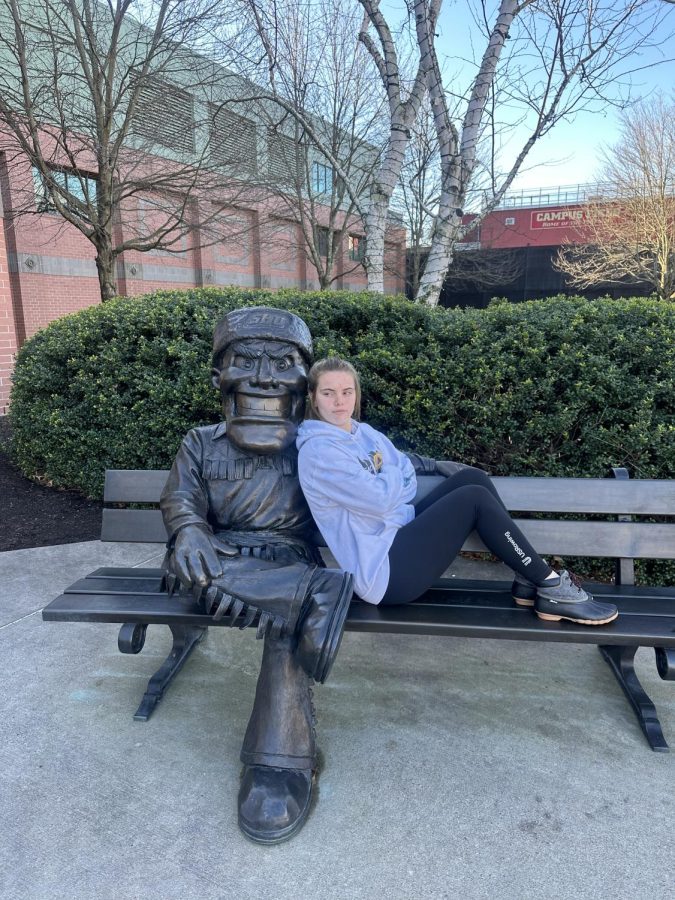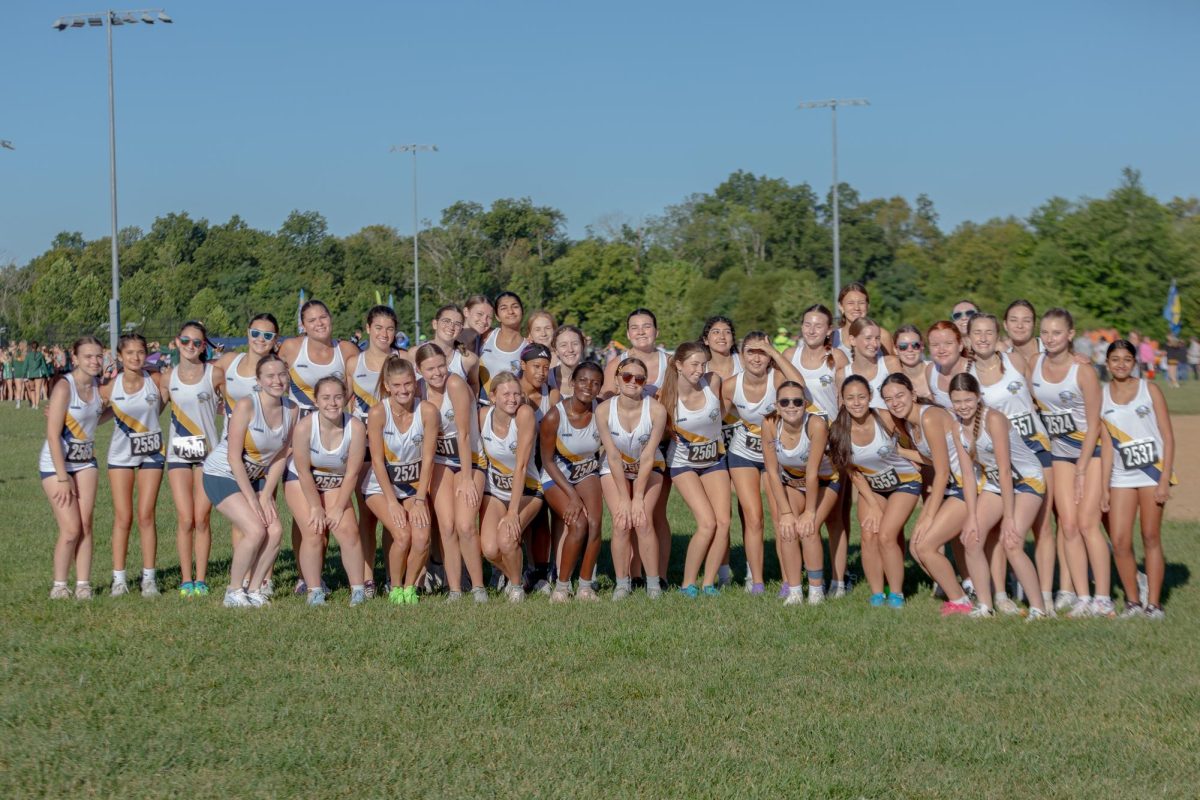Kaylee’s korner
How on earth do I get recruited?
Used with permission from Angela Robbins
When no one was looking, I sneakily got my mom to take this sick picture of me on a college visit. This was my first official and after the initial nervousness of it all, it was a great experience that I look forward to sharing with you guys.
January 26, 2023
As an athlete, I feel that there are three main pathways each person who wishes to play their sport in college fits into.
The first is admission. Maybe you want to go to an Ivy League that you don’t necessarily have the grades or extracurriculars to get into. Trust me, I get it. I have quite literally had a recruiter tell me, “you won’t get into our school if you don’t get in through the rowing team.” And listen, maybe you are a student who didn’t have the best grades at the beginning of high school, but you know your college career will be different.
Getting into a school for your athletic abilities is a huge accomplishment and should not be looked down upon because you didn’t have straight A’s your entire high school career.
Secondly, maybe, like many, you come from a family that doesn’t have the means to fund hundreds of thousands of dollars toward education. As the price of tuition for public and private universities soars, a huge weight can be put on our teenage brains to somehow make it through debt free. If this is you, you’re in luck because I too do not have a secret stash of $300,000 hidden away for college. You are not alone.
And the third pathway is insanity. Of course, when I say insanity, I don’t mean bouncing off the walls crazy. But, if you are willing to sell your soul for another four years of your life after high school, it is important to have just a little bit of an obsession and love for your sport. Many of my friends who I’ve seen go off to row in college have an insane passion for the sport and for their role on the team.
Anyway, if you fall into any of these categories, chances are you are looking to get recruited by a college. I am currently in the recruiting process, and while I have not committed, I can give tips and tricks that may help.
Step 1: make a profile/email
Make a profile with your stats, information, picture and any videos that you have to show interested colleges what you have to offer. Stats often include your grade, height, weight and then, depending on your sport, results from timed or weighted tests. These profiles put you in the search engines of colleges and make your information available for them to reach out to. Along with a profile, make sure to have a dedicated email, or one that you check daily, so you can be on top of reaching out and receiving information. Some recruiting websites that are good are NCSA or MaxPreps. Depending on your sport, however, individual research can be beneficial, especially for websites that may contain a membership fee.
Step 2: reach out to colleges
Once your profile is made, reaching out to colleges is the best way to get your name out there. If you already have a list of colleges you would like to attend, start by reaching out to them. I, personally, made an email template that I use for all my colleges. I change the college name and individual parts of the email, but a template is a good way to introduce yourself in a paragraph or so.
One important skill to have through this process is self-awareness. Only you know your athletic and academic abilities and potential. Reach out to colleges that you could realistically see yourself at, and don’t just try to look for prestige.
Another important thing to remember during your search is to be humble. Especially at the beginning of the search, don’t automatically cut off too many schools or coaches that reach out to you because even if you won’t go there in the end, any call is a good call to practice interviewing skills with different types of people. Each call that I have is a completely unique experience, and the way I figured out what I like in a coach was by talking to a variety of them.
Step 3: research
Especially once you set up a time to call, do some brief research on that school. Make sure you know what type of programs they offer, especially if you already know what you want to major in. Also, look up the environment. If your sport is multiple seasons, and outdoor, like mine, you may want to look at the weather year-round. Kind of get a sense of where you want to be and those questions can help you find a good match.
Step 4: set up and prepare for calls
Once you set up a call with a coach, make a quick list of 5-10 questions of basic things you would want to know about the university. When they call, you want to seem prepared and like you are interested in their program and questions are a good way to start. One mistake I’ve made during my hectic schedule is scheduling college calls during lunch. Make sure to find a quiet space where you can have a nice conversation.
Step 5: Maintain relationships
After that first call, I’ve noticed that a lot of coaches are interested in watching you make the next move. Don’t be scared to send them a new race result, or any highlights that you might have. They are interested in seeing your progress, but they won’t be hovering over your shoulder asking you to hit them up.
Step 6: visits
The hardest thing for me was understanding visits and how to set those up. Usually, towards the end of a call, I ask the question “so what does the process for your recruits usually look like from here?” This will lead them to talk about the next step and what they’ll want to see from you in the future.
Step 7: make a list
After a few calls, it should be easy to make a list of your top 5-10 schools with the contacts of the recruiters/coaches. This list is handy for when you want to send out an update to multiple coaches or even just so you can easily visualize your top schools.
One last thing to do is, once you have your final decision and you are ready to commit, make sure to email or text recruiters from your other top schools to let them know that you are going in a different direction. Most coaches are understanding and will appreciate you reaching out to let them know.
Step 8: remember your education
This last step is the most important step. The biggest question you need to ask yourself when you are deciding on your college is “could I be happy here if I didn’t play a sport?” If you completely decide on a college simply because they want you to come to play for them but you don’t like the environment, the type of programs they offer and you just overall couldn’t see yourself having an enjoyable time, save yourself and your family the time and money and go in a different direction. Hopefully, you never face an injury but if something were to happen where you couldn’t play anymore or you didn’t want to, the school will become a nightmare, and a transfer portal will start to look really nice- which should never be the case.
I hope this was helpful and, as always, please send in questions or comments about things I should write about to be the most helpful to you all through this process using the form: Kaylee’s Korner questionnaire
Tune in to my next column to hear about one of the biggest questions any student-athlete asks at one point or another: How do I deal with my mental health in sports?







